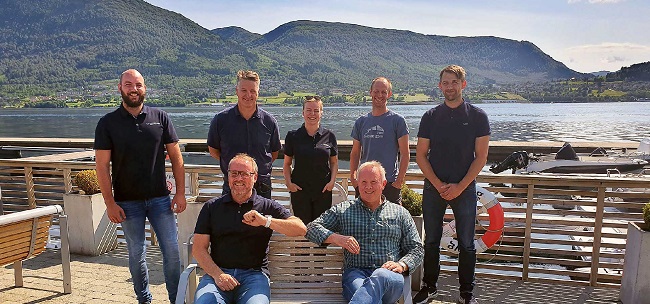
Industry update
News
Management
Technology
Billund nets deal to build RAS for Mowi’s Norway farm
November 5, 2020 By Nestor Arellano
 In front to the left: Sondre Høidalen, CEO Billund Aquaculture Norway and John-Ivar Sætre, production manager freshwater Mowi. Behind to the left, Jesper Nissen Nielsen, project manager Billund Aquaculture, Marius Hægh, CTO Billund Aquaculture Norway, Tilla Øygard, process engineer Billund Aquaculture Norway, Paul Henning Haugom, area operational manager freshwater, Mowi. (photo: Billund Aquaculture Norway)
In front to the left: Sondre Høidalen, CEO Billund Aquaculture Norway and John-Ivar Sætre, production manager freshwater Mowi. Behind to the left, Jesper Nissen Nielsen, project manager Billund Aquaculture, Marius Hægh, CTO Billund Aquaculture Norway, Tilla Øygard, process engineer Billund Aquaculture Norway, Paul Henning Haugom, area operational manager freshwater, Mowi. (photo: Billund Aquaculture Norway) Recirculating aquaculture system provider Billund Aquaculture has signed an agreement to complete the RAS installation work at Mowi’s fry production plant in Haukå, Norway.
Last year, Mowi engaged Billund to install a new RAS facility in the Haukå site. This project is now in its final stages.
The facility’s permit covers the production of 7.5 million fish annually.
The newer and far larger supply agreement includes RAS, piping, electrical, energy plant, feed system, and other equipment, according to press release from Billund.
Billund is working on the project with civil contractor Veidekke, a major player in the Norwegian market.
“This is a milestone in our history. For it will be the largest task since our Norwegian based company’s inception in 2017,” said Billund director and chief technology officer Marius Hægh.
This next stage will involve the construction of two equal production lines. Each line will have fish tank volume of approximately 5,000 m³ and feed capacity of 4,400 kg. Both production lines will use moving bed biofilm reactors (MBBR) for treating process water.
“The choice of biological treatment method depends on several factors such as the consumption of water and experiences from other facilities and more,” said John-Ivar Sætre, Mowi’s freshwater production manager for the region. “In our judgment, we are best served by moving bed – also in terms of continuity associated with existing installations.”
The Haukå facility will use brackish water with salinity up to 20 per-ml.
“It’s not applicable now,” Sætre said. “But in the long term, it may be desirable to use seawater. And then we have to take into account, among other things, materials that can withstand salt water”.
Print this page